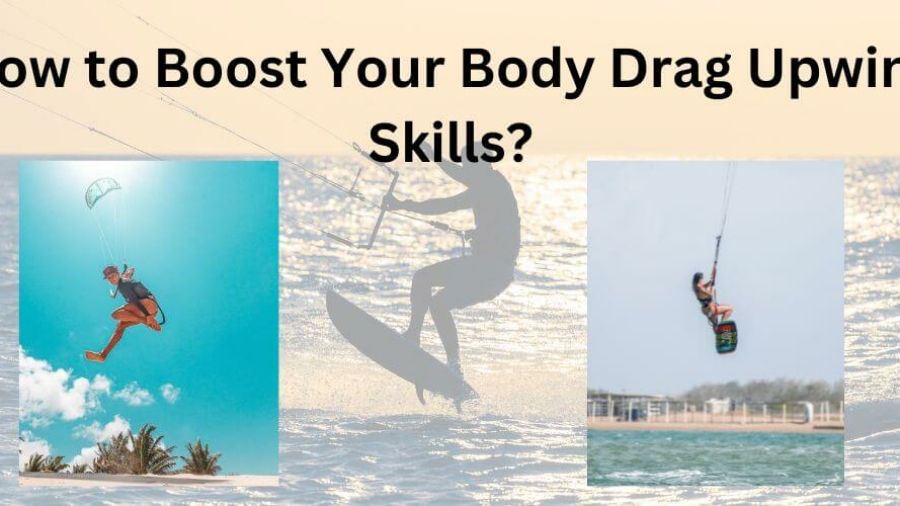While you have passed the beginners phase, and now that you are looking to upgrade your skills to an advanced level of kitesurfing, it becomes essential to learn the upwind body dragging skill to go deeper into the water and to start practicing without an instructor. This is one of the crucial skills to learn while you finally complete your beginners’ lessons on kitesurfing. It is a technique that allows you to navigate against the direction of the wind.
Why Learn Body Drag Upwind Skills?
Body dragging upwind is a foundational skill when kitesurfing as it enables the rider to efficiently navigate upwind. Upwind body dragging is term used not only in kitesurfing, but also in sailing and windsurfing. Body Drag Upwind skill basically involves using the kite to pull your body to tack upwind.
By mastering this foundational technique, you will have greater control over your movements on the water, which allows you to explore new spots, recover your board, and ensure your safety in any challenging conditions. If you are looking to kitesurf only in perfectly flat or not below the waist-deep waters, then you can skip or delay learning this skill. But if you wish to further your skills and become an independent rider, then this skill should be your priority. Let’s delve deeper into it.
Tips for Body Dragging While Kiteboarding
Though upwind body dragging is a basic skill that everyone learns, many makes mistake in performing the same. With the tips on the same, you can efficiently perform the skill.
1. Maintain the Right Body Drag Angle
One of the most crucial things for learning the body drag upwind skill is maintaining the right angle. The relative angle between the wind and the direction of your body, determines the performance of upwind. When there is greater angle of this attack, you go less upwind, and closer to just body drag sidewind or even worse can happen, which downwind.
Hence, it is crucial to have a smaller angle for this attack, which makes the upwind steeper and gets you closer to the critical angle. This angle should be as small is 30 degrees, but for the kitesurfer’s body, where the resistance is higher, the critical angle can be 60 degrees. When executing a body drag upwind angle, it is crucial to maintain that slight angle against the wind. This angle generates the forward momentum while also allowing you to make some progress upwind.
2. Breaking It Down
Breaking down or dragging down can be divided into three parts. Initially, you can pursue and understand what effects the kite has on the proceedings, then you can ponder on the effect of your body weight on the kite, and then figure out how it all fits together in the real-life situation. To improve your body dragging technique, you must focus on each component individually like your hand position, your body posture, and your control over the kite.
This way, you will be able to efficiently move through the wind, take turns, and have control of your board as well. By refining each element separately, you will develop more fluid and efficient control on the technique.
3. Swing High
When the kite lifts you high, between around 11.30 to 12.30, you are lifted out of water with the kite. With this lift, the kite might pull you downwind a little, which then moves in the direction of the wind. To reduce the drag downwind while you change the kite side, you can swim upwind with your legs.
4. Swing Low
If you are unable to drag yourself upwind, you can ride your kite lower, and near the water. This highly depends on the power of your kite and your skills level. When you maintain a proper leg position by extending your legs and keeping the close together, you minimize the resistance and maximize your ability to glide through the water with ease. Only downside of using this technique is you get a lot wet, might bring a mouthful of water, which may eventually loosen your grip of the equipment.
5. Adjust the Kite Position
When you try to drag body upwind, the optimal kite position should be around 45 degrees. This position enables you to pull the kite in your desired direction along with uplifting it, while aiding you in holding the balance on water. When you adjust the bar to control the power, you must ensure a smooth and controlled movement though the water for efficient upwind lift.
6. Anticipate Wind Changes
When the wind direction shifts, it is vital to anticipate these changes, and adjust your body position accordingly. To change the direction, slowly move the kite (while keeping it close to the border of window). This slow movements aids in minimizing the drag downwind when the wind direction shifts. By staying proactive while riding the kite, you will be able to maintain your forward progress over the skill and effectively navigate against the wind.
7. Practicalities
After following every step, there still is a possibility that you tumble. In such situation, you must first check on your bearings, especially where your board is. Once you find your board, take the control of your kite and the harness. As you get a hold of kite and it starts pulling you up, you must push it down, this will enable you get the complete control of the kite and then slowly move the kite in the direction of the shore. This will aid you in saving yourself, your eyes and lungs.
To master this body drag upwind skill, you must regularly practice. Also, experimenting with different wind and water conditions will build confidence and proficiency in you. Always seek feedback from our experienced riders at the Kitesurf School Algarve, to fine-tune your techniques and accelerate your overall progress.
